Reproduction in Organism | Olympiad Preparation for Class 10 PDF Download
How do Organisms Reproduce?
When we see around us, we observe that there is continued existence of species on this earth. There is likeness and copy in each species. Their existence is not going to end. We wonder how does this take place? Living organisms maintain their existence on this earth by a process called reproduction. Now, the question arises ‘How do organisms reproduce?’.
Role of DNA in Reproduction
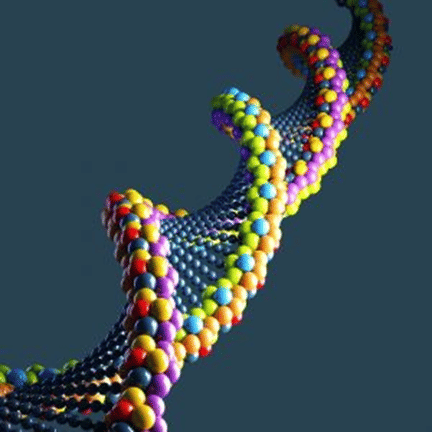
Here is the answer to the question “DO ORGANISMS CREATE EXACT COPIES OF THEMSELVES?”. First of all, let’s talk about the definition of reproduction in living organisms.
- The biological process by which every living organism produces a new organism that is very similar to themselves is known as
- This similarity in body designs is caused by the copy of DNA (Deoxyribonucleic Acid) which causes the inheritance of features from parents to the next generation.
- The DNA present in the cell nucleus is the information source for making proteins.
- The primary focus of reproduction in any living organism is the production of DNA copy.
- The consistency of DNA copying during reproduction is important for the maintenance of body design features that allow the organism to use that particularly suitable environment.
Importance of Variation
- Reproduction is the basis of the stability of the population of organisms on this earth.
- On this earth, each organism finds its suitable place (niche) to live and they are fit for that.
- If every organism has the same body features then it will be difficult for them to keep their species' existence for a long time.
- However, if some variations were to be present in a few individuals in these populations, there would be some chance for them to survive.
- The DNA copying mechanism cannot be absolutely accurate, and the resultant errors are a source of variations in populations of organisms.
- Suppose, on earth due to global warming, the temperature of water increases then all of a sudden most bacteria die but few having variation of resistance to heat can live. This saves the existence of bacteria on this earth.
Types of Reproduction
Reproduction in living organisms can be classified into two categories:
Asexual Reproduction
- If there is the involvement of only single parents in giving rise to their young ones then this mode of reproduction is called asexual reproduction.
- There may or may not be the involvement of gamete formation in asexual reproduction.
- The reproduced organisms are very much similar (genetically) to their parents.
- This type of reproduction is mainly seen in single-celled organisms, also in some plants and animals.
- Mainly reproduction in plants is carried out in the asexual mode of reproduction.
Types of Asexual Reproduction
(1) Binary Fission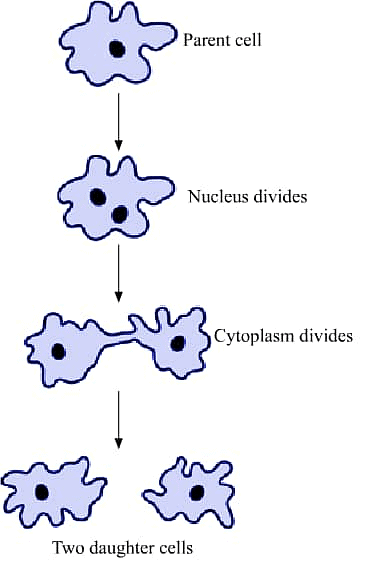
- This mode of reproduction is termed a division in half.
- When the parent body divides into two identical halves and each half grows into a similar organism to a parent. This process is called binary fission.
- This type of reproduction is mainly seen in a unicellular organism.
- Unicellular organisms like amoeba split into two cells in any orientation (in any plane).
- During cell division, many bacteria and protozoa simply split into two equal halves.
- The malarial parasite, Plasmodium, divides into many daughter cells simultaneously by multiple fission.
(2) Fragmentation: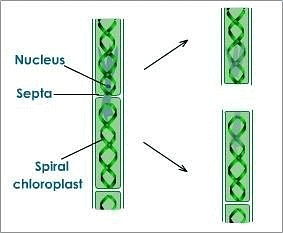
- This type of asexual reproduction is mainly observed in multicellular organisms having simple body organization.
- Here parent organism breaks into fragments and each individual fragments have the potential to grow into a new organism.
- Spirogyra reproduces by fragmentation.
(3) Regeneration:
- In multicellular organisms with a well-differentiated body, organization regeneration is observed.
- The capability of an organism to grow into a new organism from its cut or broken part is called regeneration.
- Hydra and Planaria when cutting into any number of pieces then each piece grows into a complete organism.
- Regeneration is carried out by specialized cells which proliferate and make large numbers of cells.
(4) Budding:
- Due to repeated cell division at one specific site, a bud develops as an outgrowth in the same body.
- When this bud becomes mature, it gets de-attached from the parents' bodies and grows into a new body.
- Hydra uses its regenerative cells for reproduction.
(5) Vegetative propagation: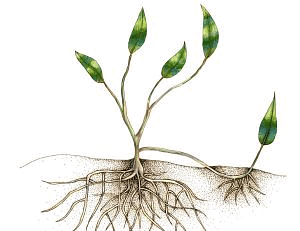
- This mode of reproduction is mainly seen in plants.
- Only a single plant is involved in this process.
- In this mode of asexual reproduction, a new offspring plant is obtained from any stem, root, or leaf (the vegetative part of the plant).
- Plants grown by vegetative propagation can bear flowers and fruits earlier than those grown from seeds.
(6) Spore Formation: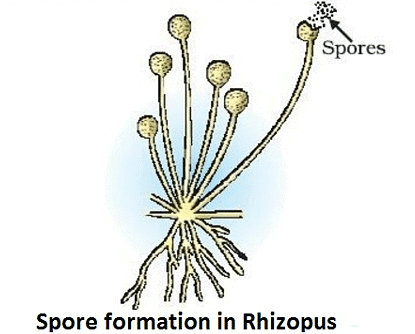
- This mode of asexual reproduction is mainly observed in non-flowering plants.
- The parent plant produces hundreds of tiny spores and each spore gives rise to a new plant.
- Some fungi (Rhizopus) and bacteria exhibit spore formation.
Sexual Reproduction
- When there is the involvement of two parents to produce their young ones similar to them. Then this mode of reproduction is called sexual reproduction.
- Both male and female gametes are involved to reproduce.
- Either the same individual or by different individuals of the opposite sex these gametes are formed.
- Sexual reproduction incorporates a process of combining DNA from two different individuals during reproduction.
Sexual Reproduction in Flowering Plants
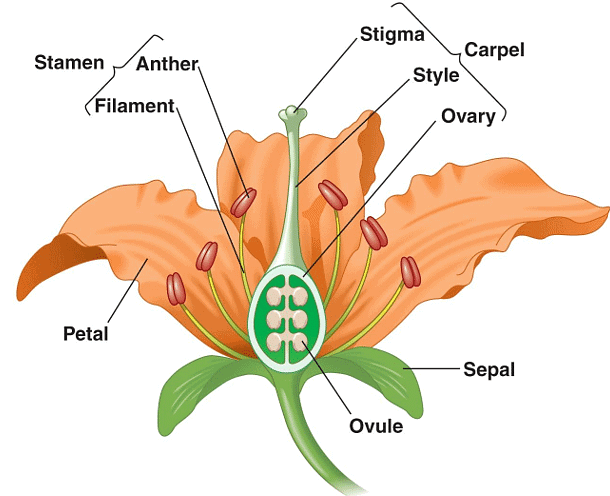
- The different parts of a flower are – sepals, petals, stamens, and carpels.
- The reproductive parts of a flower are stamens and carpels.
- Stamen is the male reproductive part and it produces yellow-colored pollen grains.
- Carpel is the female reproductive part and is present in the center of a flower. It consists of three parts, they are ovary, style, and stigma.
- In the ovary there are ovules and each ovule contains an egg cell.
- Pollen grains produce male germ-cell which fuse with the female gamete present in the ovule.
- The fusion of the germ cells (fertilization) forms the zygote which grows into a new plant.
- When there is the transfer of pollen grains from stamen to stigma occurs in the same flower, it is self-pollination.
- When there is the transfer of pollen grains from the stamen of one flower to the stigma of another flower then it is cross-pollination.
- The transfer of pollen from one flower to another flower is carried out by the wind, water, insects, or animals.
- Pollen grains after reaching stigma has to move towards female germ cells present in the ovary. This is carried through a long tube that travels through the style and reaches the ovary.
- After fertilization, the zygote forms an embryo within the ovule after dividing itself many times.
- The ovule develops and is later converted into a seed while the ovary ripens to form fruit.
- The seed after getting suitable conditions grows into a new plant, this process is called.
Changes that take place in teenagers (puberty)
- Height and weight increase up to teenage in boys as well as girls.
- We acquire new teeth also milk teeth got broken new one take place of it.
- In boys as well as girls thick hair starts growing in the armpits and the genital area between the thighs, which also becomes darker in color.
- The skin starts becoming oily and we might begin to develop pimples.
- In girls, breast size starts increasing, with the darkening of the skin of the nipples at the tips of the breasts.
- Also, the menstruation cycle starts in girls.
- The facial hair of boys starts growing and their voice becomes harder.
- Occasionally, the penis begins to become enlarged and erect, either in daydreams or at night.
- All the changes take place over months, in some person these changes takes place earlier and in some after some age.
- In simple, Sexual maturation of the body starts.
- When our general body growth slows down, then reproductive tissues (sexual maturation) start becoming mature.
Reproduction in Human
- Human beings use the sexual mode of reproduction to keep their existence on this earth.
- Reproduction in humans involves germ cells of two individuals of the opposite sex joining together.
- Either external release of germ cells from the bodies of individuals or two individuals joining their bodies together for internal transfer of germ cells is required for sexual reproduction.
- Sexually mature individuals having mature reproductive organs and breasts can take part in this process of reproduction.
- Special organs are there in humans to transfer germ cells from one body to another.
- Reproduction in animals is mainly a sexual mode of reproduction.
Male Reproductive System
There are several parts of the male reproductive system:
(i) Testes or testicles: The production of germ cells (sperms) takes place in testes. These are present outside the abdominal cavity in a bag-like structure called the scrotum. Sperm formation requires a lower temperature than normal human body temperature. It also secretes a hormone named testosterone that regulates the formation of sperms which brings changes in teenagers.
(ii) Vas deferens: The sperms formed in testes are transferred through the vas deferens. This tube joins with the tube coming from the urinary bladder forming a common passage for both sperms and urine.
(iii) Prostate glands and seminal vesicles: These glands are present at the path of vas deferens. They add their secretions to the sperms to make them fluid. By this transport of sperms becomes easier. This fluid also provides nutrition.
(iv) Sperms: The tiny bodies that consist of mainly genetic material and a long tail that helps them to move towards the female germ cell.
Female Reproductive System
There are several parts of the female reproductive system:
- Ovaries: The female gamete (egg or germ cells) are formed at this site. Some hormones are also produced inside the ovaries. The egg is produced every month by one of the ovaries.
- Oviducts: These are also called fallopian tubes. By this passage, the egg is carried from the ovary to the womb.
- Uterus: The two oviducts unite into an elastic bag-like structure called the uterus. The uterus ends in the vagina through the cervix. It is also called the womb. It supports the developing fetus during pregnancy.
- Vagina: The vagina is an elastic, muscular tube. It connects between the cervix of the uterus to the exterior of the body. The vagina accepts the penis during sexual intercourse. It also carries sperm to the uterus and fallopian tube. It also acts as a birth canal as well as menstrual flow also exists out the body through it.
Mechanism of Reproduction
- The sperms enter inside the female body through the vagina during sexual intercourse.
- They travel in the oviduct where they meet eggs.
- Now the fertilized eggs (zygote) settle in the uterus and start dividing.
- The mother’s body is ready to undertake the development of a child.
- Uterus prepares itself every month to receive and nurture the growing embryo.
- The line of the uterus is richly supplied with blood to nourish the growing embryo.
- The placenta is a special tissue in the mother’s body that provides nutrition to the embryo from the mother’s blood.
- Villi present at the uterine wall provide a better surface area for glucose and oxygen to pass to the embryo.
- Waste materials from the embryo are removed through the placenta by transferring them to the mother’s blood.
- Approximately, nine months are required for the development of a child inside the mother’s uterus.
|
70 videos|242 docs|187 tests
|
FAQs on Reproduction in Organism - Olympiad Preparation for Class 10
| 1. How do organisms reproduce? |  |
| 2. What are the different methods of asexual reproduction in organisms? |  |
| 3. How does sexual reproduction ensure genetic variation in organisms? |  |
| 4. What are the advantages of asexual reproduction in organisms? |  |
| 5. Are there any disadvantages of asexual reproduction in organisms? |  |
















